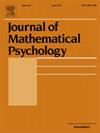Two formal notions of higher-order invariance detection in humans (A proof of the invariance equivalence principle in Generalized Invariance Structure Theory and ramifications for related computations)
IF 1.5
4区 心理学
Q2 MATHEMATICS, INTERDISCIPLINARY APPLICATIONS
引用次数: 0
Abstract
Invariance and symmetry principles have played a fundamental if not essential role in the theoretical development of the physical and mathematical sciences. More recently, Generalized Invariance Structure Theory (GIST; Vigo, 2013, 2015; Vigo et al., 2022) has extended this methodological trajectory with respect to the study and formal modeling of human cognition. Indeed, GIST is the first systematic and extensively tested mathematical and computational theory of concept learning and categorization behavior (i.e., human generalization) based on such principles. The theory introduces an original mathematical and computational framework, with novel, more appropriate, and more natural characterizations, constructs, and measures of invariance and symmetry with respect to cognition than existing ones in the mathematical sciences and physics. These have proven effective in predicting and explaining empirically tested behavior in the domains of perception, concept learning, categorization, similarity assessment, aesthetic judgments, and decision making, among others. GIST has its roots in a precursor theory known as Categorical Invariance Theory (CIT; Vigo, 2009). This paper gives a basic introduction to two different notions of human invariance detection proposed by GIST and its precursor CIT: namely, a notion based on a cognitive mechanism of dimensional suppression, rapid attention shifting, and partial similarity assessment referred to as binding (s-invariance) and a perturbation notion based on perturbations of the values of the dimensions on which categories of object stimuli are defined (p-invariance). This is followed by the first simple formal proof of the invariance equivalence principle from GIST which asserts that the two notions are equivalent under a set of strict conditions on categories. The paper ends with a brief discussion of how GIST, unlike CIT, may be used to model probabilistic process accounts of categorization, and how it naturally and directly applies to the learning of sequential categories and to multiset-based concept learning.
人类高阶不变性检测的两个形式化概念(广义不变性结构理论中不变性等价原理的证明及其计算结果)
在物理和数学科学的理论发展中,不变性和对称性原理即使不是必不可少的,也起到了基本的作用。最近,广义不变性结构理论(GIST;维戈,2013,2015;Vigo et al., 2022)在人类认知的研究和形式化建模方面扩展了这种方法轨迹。事实上,GIST是基于这些原理的概念学习和分类行为(即人类泛化)的第一个系统的和广泛测试的数学和计算理论。该理论引入了一个原始的数学和计算框架,与现有的数学科学和物理学相比,它具有新颖、更合适、更自然的特征、结构和认知不变性和对称性的度量。这些方法在预测和解释知觉、概念学习、分类、相似性评估、审美判断和决策等领域的经验测试行为方面已被证明是有效的。GIST起源于一个被称为范畴不变性理论(CIT;维哥,2009)。本文对GIST及其先驱CIT提出的两种不同的人类不变性检测概念进行了基本介绍:基于维度抑制、快速注意力转移和部分相似性评估的认知机制的概念称为绑定(s-不变性)和基于定义对象刺激类别的维度值的扰动(p-不变性)的概念。这是GIST对不变性等价原理的第一个简单形式证明,它断言这两个概念在一组严格的范畴条件下是等价的。本文最后简要讨论了GIST如何与CIT不同,可以用于对分类的概率过程帐户进行建模,以及它如何自然而直接地应用于顺序类别的学习和基于多集的概念学习。
本文章由计算机程序翻译,如有差异,请以英文原文为准。
求助全文
约1分钟内获得全文
求助全文
来源期刊

Journal of Mathematical Psychology
医学-数学跨学科应用
CiteScore
3.70
自引率
11.10%
发文量
37
审稿时长
20.2 weeks
期刊介绍:
The Journal of Mathematical Psychology includes articles, monographs and reviews, notes and commentaries, and book reviews in all areas of mathematical psychology. Empirical and theoretical contributions are equally welcome.
Areas of special interest include, but are not limited to, fundamental measurement and psychological process models, such as those based upon neural network or information processing concepts. A partial listing of substantive areas covered include sensation and perception, psychophysics, learning and memory, problem solving, judgment and decision-making, and motivation.
The Journal of Mathematical Psychology is affiliated with the Society for Mathematical Psychology.
Research Areas include:
• Models for sensation and perception, learning, memory and thinking
• Fundamental measurement and scaling
• Decision making
• Neural modeling and networks
• Psychophysics and signal detection
• Neuropsychological theories
• Psycholinguistics
• Motivational dynamics
• Animal behavior
• Psychometric theory
 求助内容:
求助内容: 应助结果提醒方式:
应助结果提醒方式:


